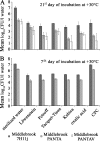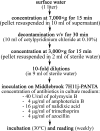Comparison of culture methods for isolation of nontuberculous mycobacteria from surface waters
- PMID: 20363776
- PMCID: PMC2876437
- DOI: 10.1128/AEM.02659-09
Comparison of culture methods for isolation of nontuberculous mycobacteria from surface waters
Abstract
The environment is the likely source of most nontuberculous mycobacteria (NTM) involved in human infections, especially pulmonary, skin, and soft tissue infections. In order to measure the prevalence of NTM in different aquatic ecosystems, we tried to standardize the culture methods used for surface water testing since many procedures have been described previously. Cultivation of mycobacteria requires long-term incubation in rich media and inactivation of rapidly growing microorganisms whose growth impedes observation of mycobacterial colonies. Consequently, the two criteria used for evaluation of the methods examined were (i) the rate of inhibition of nontarget microorganisms and (ii) the efficiency of recovery of mycobacteria. We compared the competitive growth of Mycobacterium chelonae and M. avium with nontarget microorganisms on rich Middlebrook 7H11-mycobactin medium after treatment by several chemical decontamination methods that included acids, bases, detergent, or cetylpyridinium chloride (CPC) with and without an antibiotic cocktail, either PANTA (40 U/ml polymyxin, 4 microg/ml amphotericin B, 16 microg/ml nalidixic acid, 4 microg/ml trimethoprim, and 4 microg/ml azlocillin) or PANTAV (PANTA plus 10 microg/ml vancomycin). Our results showed that treatment for 30 min with CPC (final concentration, 0.05%) of water concentrated by centrifugation, followed by culture on a rich medium supplemented with PANTA, significantly decreased the growth of nontarget microorganisms (the concentrations were 6.2 +/- 0.4 log(10) CFU/liter on Middlebrook 7H11j medium and 4.2 +/- 0.2 log(10) CFU/liter on Middlebrook 7H11j medium containing PANTA [P < 0.001]), while the effect of this procedure on NTM was not as great (the concentrations of M. chelonae on the two media were 7.0 +/- 0.0 log(10) CFU/liter and 6.9 +/- 0.0 log(10) CFU/liter, respectively, and the concentrations of M. avium were 9.1 +/- 0.0 log(10) CFU/liter and 8.9 +/- 0.0 log(10) CFU/liter, respectively). We propose that this standardized culture procedure could be used for detection of NTM in aquatic samples.
Figures




References
-
- Bange, F. C., and E. Böttger. 2002. Improved decontamination method for recovering mycobacteria from patients with cystic fibrosis. Eur. J. Clin. Microbiol. Infect. Dis. 21:546-548. - PubMed
-
- Buijtels, P. C. A. M., and P. L. C. Petit. 2005. Comparison of NaOH-N-acetyl cysteine and sulfuric acid decontamination methods for recovery of mycobacteria from clinical specimens. J. Microbiol. Methods 62:83-88. - PubMed
Publication types
MeSH terms
Substances
Associated data
- Actions
- Actions
- Actions
- Actions
- Actions
- Actions
- Actions
- Actions
- Actions
- Actions
- Actions
- Actions
- Actions
- Actions
- Actions
- Actions
- Actions
- Actions
- Actions
- Actions
- Actions
- Actions
- Actions
- Actions
- Actions
- Actions
LinkOut - more resources
Full Text Sources
Other Literature Sources
Molecular Biology Databases

